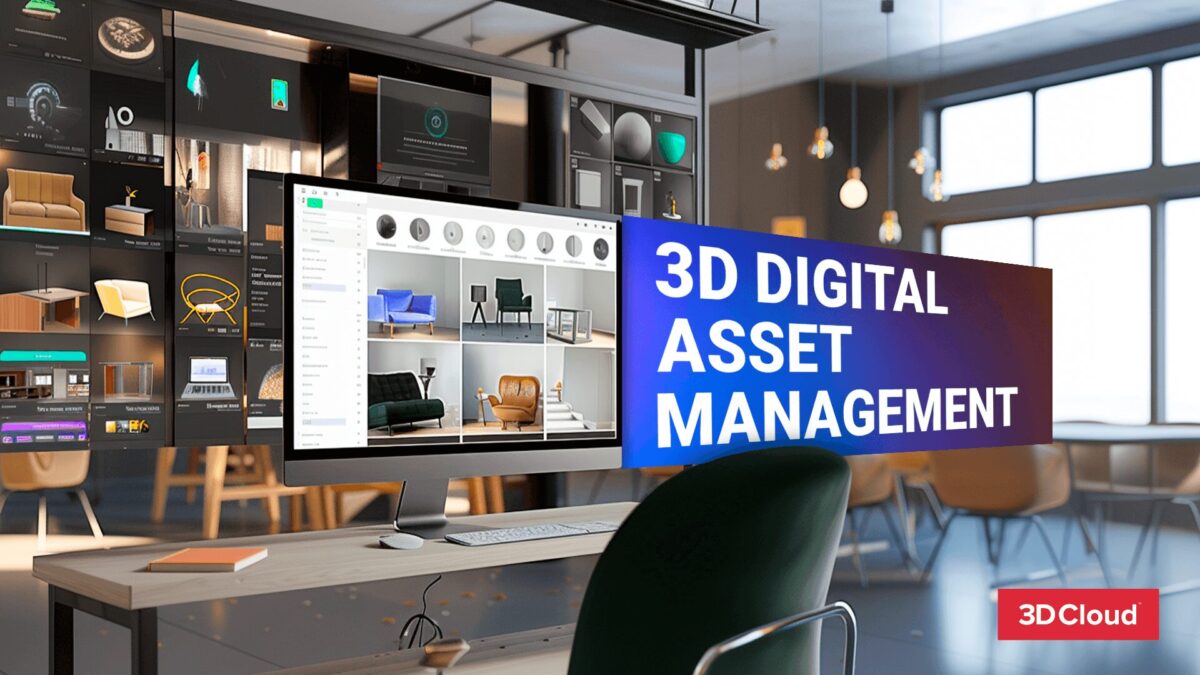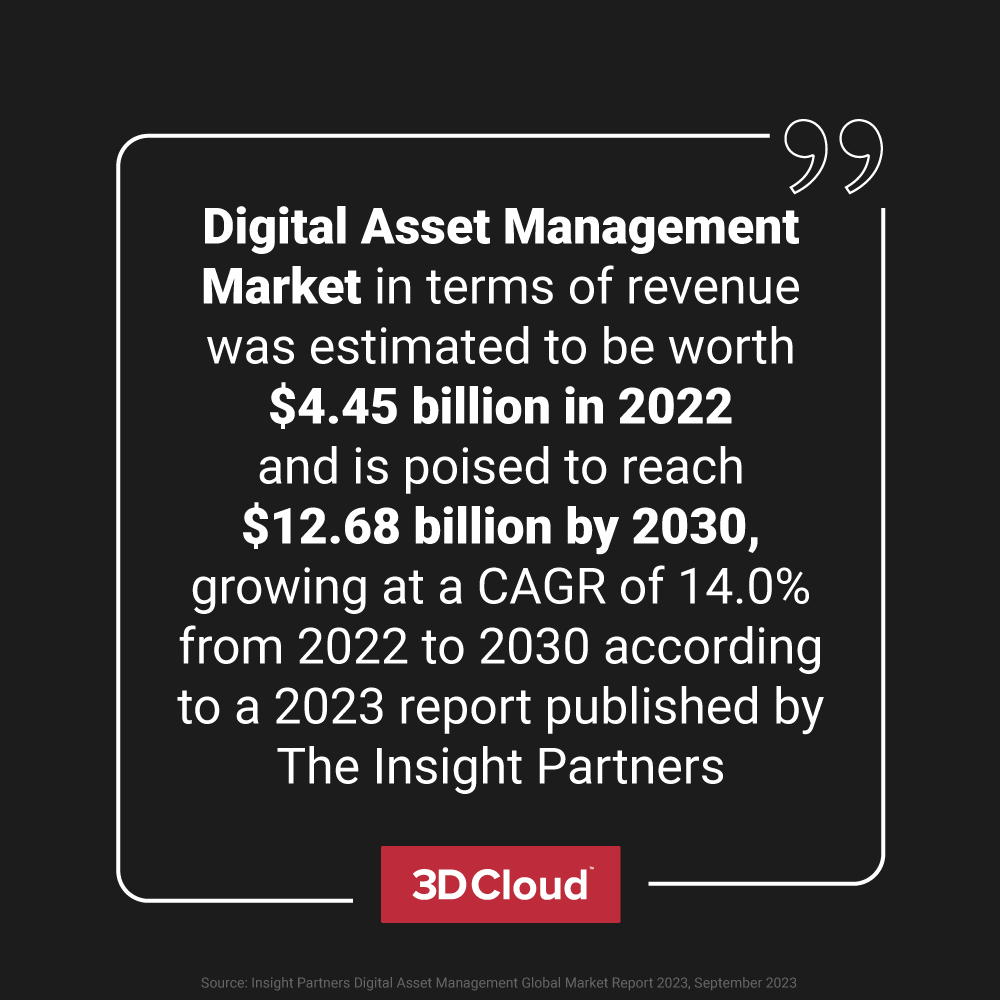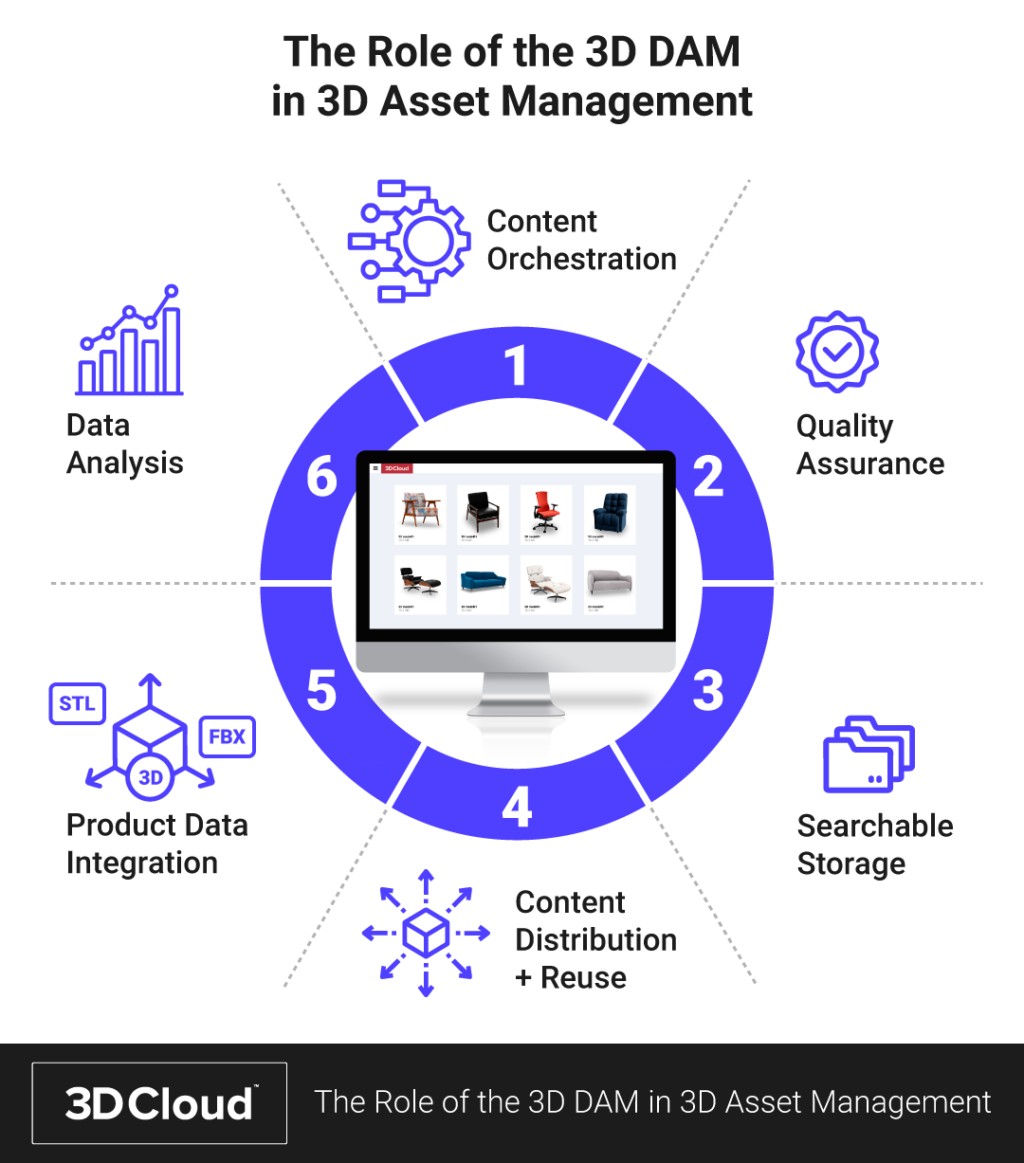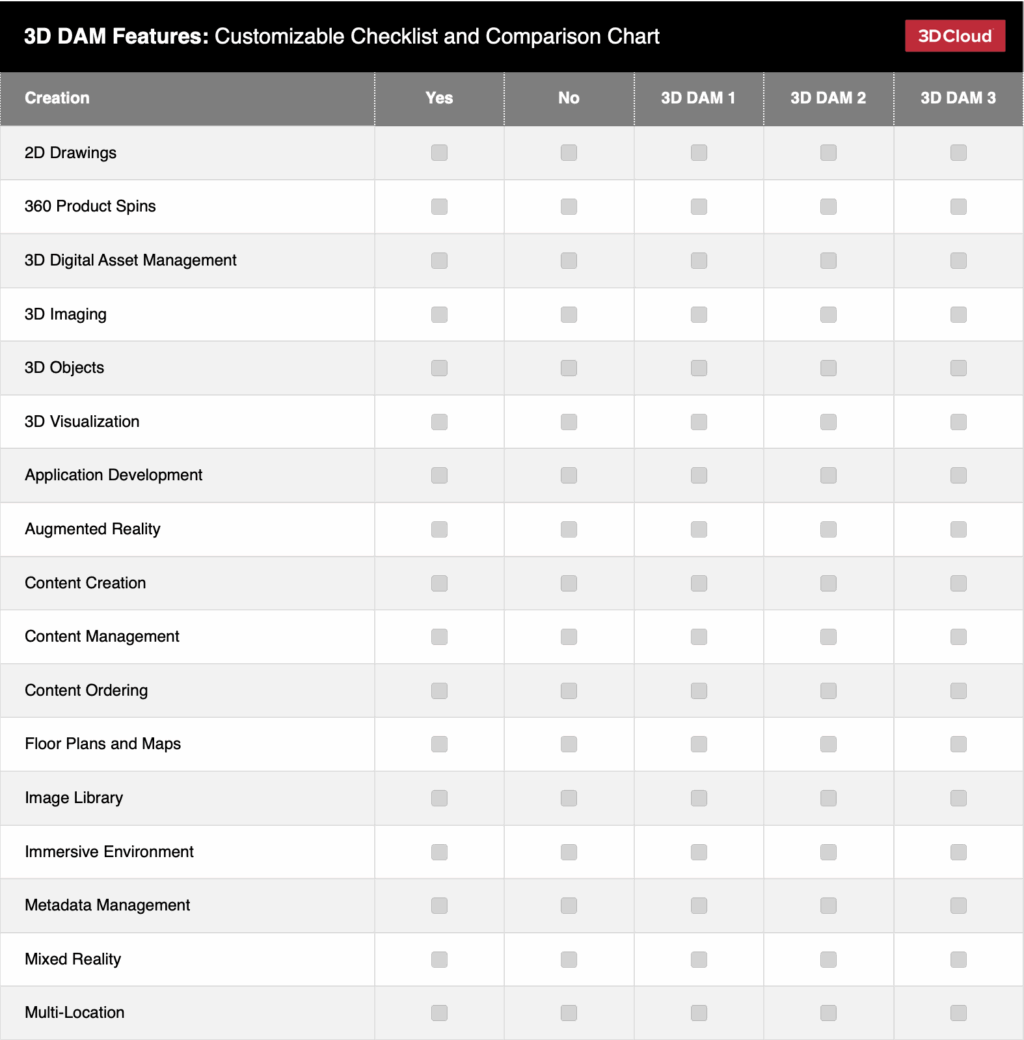
Innovative 3D content and marketing can drive revenue, but you also need efficient 3D asset management. This article explains how that works and helps you find solutions.
Inside this article:
What is 3D asset management?
3D asset management encompasses the software and workflows used to manage and distribute 3D digital assets. 3D asset management systems can also be called 3D DAMs, standing for 3D digital asset management. 3D DAMs enable enterprises to effectively manage 3D content for e-commerce, gaming, virtual reality, and more.
3D content can include 3D models (also called geos or geometries), materials, textures and animations. Retailers use 3D content for 3D ecommerce, while other types of businesses may use a 3D DAM to manage 3D content that is used in entertainment or gaming experiences. A 3D DAM organizes makes it easier to orchestrate and manage large catalogs of 3D assets, enabling collaboration and efficient processes.
Many retailers and brands are using WebAR to help shoppers visualize purchases in context and to create immersive consumer experiences. While a small catalog of a few hundred products or gaming assets may be manageable without a 3D DAM, enterprise ecommerce experiences that use WebAR for thousands or tens of thousands of SKUs require a 3D DAM to manage 3D product and materials and ensure accuracy at scale.
3D DAM platforms give businesses a competitive edge in fields ranging from aerospace and architecture to healthcare and gaming.


How a 3D DAM supports marketing efforts
A 3D DAM makes it easier to create, find, utilize, and manage 3D assets at scale by organizing the following processes into an intuitive web-based system.
How is a 3D DAM different from a traditional DAM?
Traditional digital asset management (DAM) software is a repository for 2D images, videos, logos, audio files, documents, and other multimedia assets. 3D DAMs offer additional features for managing 3D products and 3D assets that are used in spatial computing, 3D commerce, and 3D design applications. Both software platforms are used to organize, manage, share, measure, and publish digital content.
 “While traditional DAMs share many features and functionalities with 3D platforms, 3D assets have unique qualities that require a specialized 3D DAM to make them usable and performant in 3D commerce, 3D product configuration, and 3D room planning applications,” said Beck Besecker, CEO & Co-Founder of 3D Cloud.
“While traditional DAMs share many features and functionalities with 3D platforms, 3D assets have unique qualities that require a specialized 3D DAM to make them usable and performant in 3D commerce, 3D product configuration, and 3D room planning applications,” said Beck Besecker, CEO & Co-Founder of 3D Cloud.
“3D DAMs extend the benefits of traditional DAMs to enhance all aspects of 3D content pipelines, from creation and management to distribution and regulation,” he says. “Enterprise-level 3D DAMS provide additional features for business-critical actions such as content review, promotion/demotion, and reuse. Effective 3D DAMs also follow a ‘create once, use everywhere’ philosophy, with the ability to reuse the same 3D content across multiple platforms such as mobile, web, and desktop is native.”
Features of 3D asset management systems
The features of 3D DAMs enable creators to manage their work through implementation. The features include 3D asset organization, content orchestration, quality assurance, asset storage and search, content distribution and re-use, product data integration, and analytics. These features allow enterprises to manage 3D asset quality while improving speed, time to market on projects that utilize 3D products.
Best-in-class 3D DAMs are cloud-based and offer features including:
- Simplified asset organization, search and retrieval: DAM systems allow users to categorize assets using metadata, keywords, tags, and custom attributes to access assets easily.
- Ongoing version control and lifecycle tracking: DAM systems often include versioning. That allows users to track asset changes.
- Seamless collaboration, distribution and sharing: Teams and customers can comment, annotate, and give feedback or approvals on projects.
- Internal and external distribution and sharing: Share assets internally or externally with links or downloadable files.
- Integration and infrastructure: Integrate with other tools and software, such as content management systems and marketing platforms.
- Analytics: See how assets perform and gain insights for marketing, design, advertising, or other purposes.
- Managing metadata: Users can define and manage metadata associated with each asset.
- Scalability: Enterprise systems must be able to manage massive volumes of digital assets, as asset libraries inevitably expand.
- Security, access control and role-based permissions: Only authorized users can view, share, edit or download assets.
Benefits of 3D asset management systems
The main benefits of 3D asset management systems are efficiency, scalability, and security. 3D DAM systems save time, avoid errors, and improve team and client collaboration.

“The architecture of a good 3D DAM incorporates a variety of technologies to support network traffic, manage internal workflows and jobs; store, retrieve, and search assets and metadata; monitor system metrics; and enable access control policies,” explained Ken Moser, PhD, Senior 3D Cloud Engineer at 3D Cloud.
“These types of systems integrate multiple pipelines and multiple cloud environments into a unified architecture, known as ‘data fabrics’ for adaptable, connectable, and restrictable 3D DAMs.”
According to Moser, the many benefits of 3D digital asset management systems include:
- Scalability: A scalable 3D DAM helps to handle both the size and number of 3D assets moving through the system, especially at peak times. Applications benefit from cloud solutions with a network of edge node locations. The distance between the end user and the data center decreases, and the incoming requests get distributed to as many data centers as possible.
- Extensible: “Serverless architectures,” such as GCP Cloud Run or Azure Functions, offer solutions that scale on demand. Real-time metrics identify heavier loads in specific regions to balance them and avoid outages.
- Efficient infrastructure: A 3D DAM is extensible because it leverages an event-driven architecture. For example, when a 3D model file is uploaded to the cloud storage bucket, the service will begin processing the file, extracting metadata, and creating variants and levels of detail. Employing this architecture means new services are easy to integrate by ‘subscribing’ to desired system events.
- Flexible integration: The goal of a 3D DAM is to utilize the same 3D assets across many applications and use cases. The design of the services layer uses a standard vocabulary so developers can identify the required information. The 3D DAM should provide native support for industry standard 3D file formats (e.g., gLTF, glb, and USDZ) and leverage common protocols and APIs.
- Cloud-based: A cloud-based solution benefits organizations with multiple locations, geographically dispersed teams, or external stakeholders. DAM functions hosted in the cloud make media available faster and improve UX.
- Data security: Cloud-based solutions provide the best access to security tools. Two key security features are identity and access management (IAM) and role-based access control (RBAC). Alerts help to identify large data pulls or suspicious access attempts quickly. The best practice for any security policy is to avoid more restrictions and then adjust roles as necessary.
- Centralized access: 3D DAMs provide a unified, well-organized structure for the content pipeline. All operations use a common interface, simplifying access control, such as single sign-on (SSO).
- Asset management capabilities: 3D DAMs support digital asset management for 3D models and more, including:
- Geometry: A 3D DAM parses out metadata such as vertex and triangle counts, identification of sub-meshes for models utilizing multiple materials, and processing mesh data to create additional levels of detail (LoD). 3D DAMs should also support the conversion of geometry types, following a “create once, use everywhere” philosophy. For example, they might convert the glTF file format to USDZ or FBX.
- Materials: A 3D DAM should support material definition, which combines references to textures and other assets with values for specific physical properties that define how a mesh should appear. A key function of enterprise 3D DAMs is reusing materials across multiple products. Efficient reuse of materials reduces asset bloat and enables efficient searches across large material libraries.
- Images: A 3D DAM should support quick access to image metadata, such as resolution, compression rate, levels of detail, and file variants like PNG, WebP, and TGA. Images in a 3D DAM include textures, renderings for thumbnails, hero images, and 360 spins of mesh and material combinations.
- Product variants and reuse: An enterprise 3D DAM can define combinations of mesh and material assets at a product level, fully allowing asset reuse. An example would be a sofa model with a frame defined by a geometry asset and a cover taken from many “fabric” materials. Loosely coupling the material and geometry assets is a critical enabler of the “create once, use everywhere” philosophy.
- Assemblies and configurations: Combinations of product assets are classified as assemblies or configurations. An example would be a sectional sofa whose components may be mixed and matched. A good 3D DAM will enable defining combinations and business rules for valid combinations, eliminating the need to enumerate an exhaustive set of all possible configurations.
- Content review, distribution, and version control: A 3D DAM should provide standard versioning control for all 3D assets and metadata types. This allows the designating of available versions and in-process versions. Content and associated material options or configurations can be designated to publish in specific production applications. For example, some content may be specifically for a web viewer and others for a mobile app. Or some content may be only available in the US, while other content or content options may only be available in specific international markets. The objective is to be able to manage these asset catalogs in a code-free environment. This functionality also benefits applications requiring localized content.
- Workflow automation: Reviewing, promoting, converting, and releasing content at scale requires the 3D DAMS to support integration into automated workflows. The services layer should provide the ability to implement and monitor processes. Content ingestion pipelines, for example, will need the ability to upload batches of raw assets, specify the types of conversions to perform, and monitor whether conversion succeeded. With automatic processing based on a 3D model, it is possible to create vast amounts of content from 2D renders, video renders, 3D interactive experiences, AR, and VR.
- Metrics and monitoring: An enterprise 3D DAM should integrate analytic capabilities to track KPIs. Alerts can be implemented for system outages, asset retrieval errors, or failures in content processing.
Challenges of managing 3D assets
Managing 3D assets can be challenging with multiple stakeholders and large-scale projects. The challenges include file format variations, large file sizes, and version control. Also, collaboration across locations can be daunting without a 3D DAM.
3D asset management challenges include:
- File format variations: 3D models can come in different formats, such as glTF, FBX, OBJ, and STL. That can make compatibility across software problematic.
- Handling big files: Heavy, high-quality 3D model file sizes can be difficult to share and manage across contributors.
- Version management: Ensuring that the latest versions of 3D models are clearly labeled and accessible — and that legacy artifacts are archived.
- Tagging and metadata: Correct tagging and categorizing 3D assets for easy search and filtering is imperative. But it’s time-consuming and susceptible to human error.
- Collaborating: Coordinating work between team members is necessary but can be difficult.
- Integrating software and platforms: Seamlessly integrating multiple asset management systems is complex and usually requires custom solutions or plug-ins.
Efficient enterprise 3D digital asset management platforms can solve all these potential issues.
How does 3D asset management work?
3D asset management uses a centralized system to store, track, and retrieve digital content. A good system enables collaboration, efficiency, and tracking. It also scales well and handles 3D projects of any size.
How are 3d models stored?
Creators store 3D models and other assets in a central repository organized by folders. Consistent naming conventions simplify finding the assets. Metadata further streamlines the workflows.
A 3D DAM can be hosted on the premises or in the cloud. Teams can access the stored data from anywhere for file sharing. Cloud-based 3D asset library management is a sensible, cost-effective way to produce, manage, maintain, and distribute 3D experiences at scale.
How to manage 3D assets
Effective 3D asset management relies on organization. The first step is to designate a digital asset manager. This person audits the system, controls access, maintains the folders, and oversees workflow.
Consider these five steps for more efficient 3D asset management:
- Name and empower a digital asset manager: The individual is responsible for the DAM system. The manager adds or removes users based on an appropriate hierarchy, sets access parameters and handles governance as projects and assets expand.
- Make a thorough audit of all assets: Identify and label all assets, review or set folder structure, and list potential users.
- Stick to the ‘Single Source of Truth’ or SSOT principle: A 3D DAM should be the single repository and “single source of truth” for every stakeholder.
- Utilize role management: Based on a user hierarchy, grant internal and external stakeholders appropriate access and or functions based on their role.
- Invest in training: Provide clear training and guidelines to stakeholders.
3D digital asset management best practices
The best practices for 3D asset management center on strict protocols. They include logical naming conventions, folders, tagging, and metadata. Make processes consistent, monitor everything and adjust.
Here are some best practices to make the most of a 3D DAM investment to boost ROI:
- Clear and consistent naming: Predictable naming conventions streamline digital asset management at scale.
- Logical folder structure: Match folder structure to workflows and assigned hierarchies. Dedicate a separate project workspace to each project. Create folders for different types, categories and stages of 3D assets, like textures, models, materials, 3D renders, scenes, or other labels. Subfolders can group themes, styles, functions, or other assets related to the main folders.
- Tags and metadata: Tags and metadata are labels or keywords that describe characteristics and make searching and finding assets easier for non-technical users.
- Disciplined workflows: A digital asset’s lifecycle makes tracking logical and predictable. DAM workflows alert team members to the project’s status and next steps.
- Leverage analytics: Use detailed insights into asset usage and user engagement to identify critical workflows, marketing data, and time spent for ongoing process refinement.
How to compare 3D digital asset management software
Comparing 3D asset management software begins with current and projected business needs. Line up internal needs and future plans with the features offered by each vendor. Using this scorecard will make it easier to asses and communicate about 3D DAM options.
Overall considerations include:
1. Current and Projected Business Needs
Evaluate current and future needs focusing on project scale, growth trajectory, and specific goals for 3D Digital Asset Management (DAM).
2. Digital Asset Requirements
Identify and assess the types of 3D assets and file types to be managed, considering both current management and future functionality needs.
3. Integrations
Select software that integrates seamlessly with existing tools and APIs to enhance productivity and ease the transition to new systems.
4. Scalability
Ensure the DAM software can scale with business growth, accommodating more users, assets, and increasingly complex projects without performance degradation.
5. Security and Permissions
Examine the software’s security features, including user permissions and data encryption, to protect sensitive data and intellectual property effectively.
6. User Experience (UX) and Ease of Use
Choose a DAM system that is intuitive and user-friendly to minimize training time and maximize operational efficiency.
7. Customer Support and Training
Assess vendor support services for their responsiveness and the quality of training provided, ensuring they meet the needs of complex software environments.
8. Workflows and Processes
Determine whether the DAM software will need to support the entire workflow from product ordering to publishing, or if a simpler solution would suffice.
9. Pricing and Budget Constraints
Ensure that the budget and requirements are aligned. If the budget originally allotted for the 3D digital asset management doesn’t line up with the requirements, consider reframing the project.
This approach provides a concise framework for evaluating the suitability of various 3D DAM software options.
3D DAM customizable checklist and comparison chart
Review this list of requirements for 3D asset management platforms to compare features and simplify decision-making. Download and edit the 3D DAM checklist and comparison chart template to reflect unique business requirements.

3D DAM Features Customizable Checklist
“In my experience, there are three major aspects to consider when choosing a high-quality 3D DAM,” said Beck Besecker, CEO and Co-Founder of 3D Cloud.
“First, the system should be data-driven. Storing assets is easy — it’s harder to make them usable. Data-driven applications that rely on large product catalogs such as 3D room planners, 3D product configuration, 360 product spins, and 3D furniture rendering, require sophisticated structured data,” Besecker says.
“Second, 3D DAMs should support various levels of detail (LODs). For example, using 3D assets in augmented reality applications requires much less detail than in a virtual reality or gaming application. Third, and maybe most importantly, systems must be designed to host and distribute at scale — because growth in 3D is inevitable.”
Take control with 3D asset management that scales
3D Cloud offers unparalleled efficiency and scalability, enabling retailers to deliver high-performing 3D product experiences across mobile, web, and in-store channels.
Our comprehensive suite, from 3D digital asset management to secure, flexible platform architecture, ensures increased sales. Join top retailers like Macy’s, La-Z-Boy, and Design Within Reach in harnessing the power of 3D product visualization. Request a demo today and learn how 3D Cloud digital asset management for 3D product visualization can make immersive 3D product experiences easy to deliver and manage.










